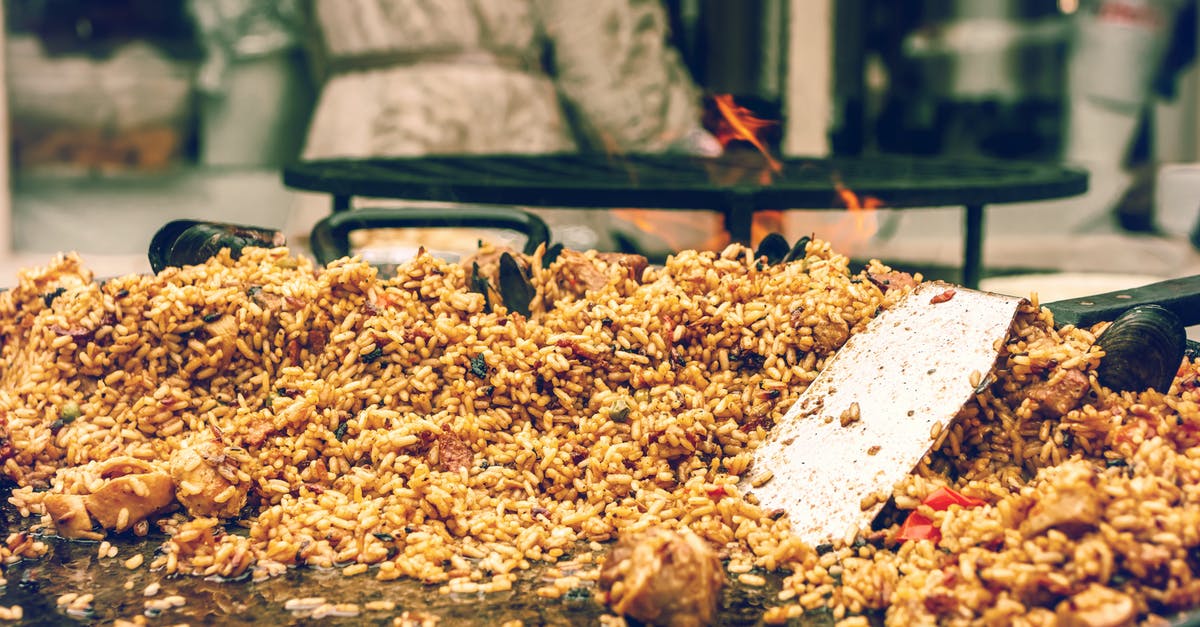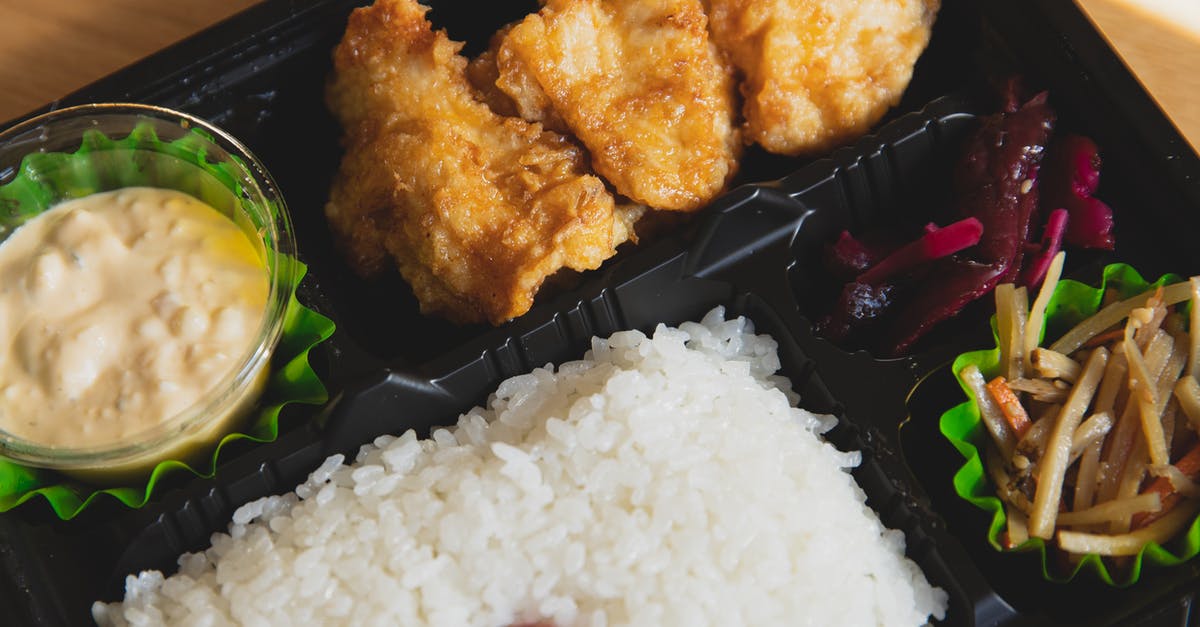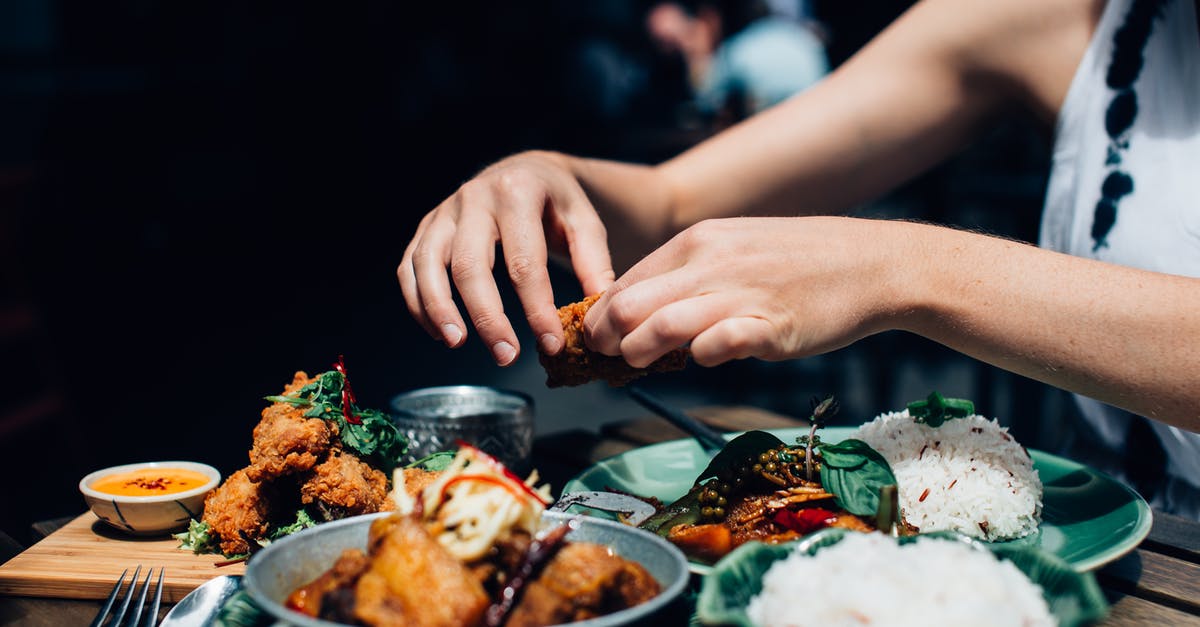Fried rice vs pulav vs biryani

How can we differentiate between fried rice, pulav and biryani? As these three rice dishes look similar, are there any differences between three of them?
Best Answer
The difference is in the preparation, which may not be as obvious when the food's served. I'm not an expert on the variations of pilaf & biryani, but here's what I understand:
Pulav / Pilaf / Pilau / Plov / Pulao / etc. are dishes where the rice is cooked in a seasoned broth. Some variants include cooking the rice in oil before adding the broth. It may contain meat, seafood, vegetables, eggs, etc. When it's finished, there's very little liquid left.
Biryani is a type of pilaf, but you cook the meat and rice separately. The rice is cooked to ~70% in a pot, optionally with very mild spices. Then a layer of meat goes at the bottom of a separate pot & the semi-cooked rice goes on top of it in layers, each layer seasoned with distinct aromatic spices. And the entire set-up is cooked on a low heat. They also tend to be more heavily spiced than Pilafs, with most of the spice generally at the bottom of the pot. They may be a bit saucy, not entirely dry. The bottom-most layer of spice mix often contains yogurt, but may include dairy or coconut milk, not just a broth. Traditionally, the giant pots are sealed with dough & the lid loaded with weight to simulate pressure cooking and while serving, they split the mix vertically to ensure every one gets a generous portion of each layer. If they're cooked in the clay pots, they aren't opened until serving, so everyone at the table gets the aroma that's released.
Fried rice uses cooked rice (some ay freshly cooked so it's fluffy, others insist you have to use day-old rice so the starche change first). You cook whatever meat or vegetables you're using in oil (typically stir-fried in a wok), and add the rice and continue to stir-fry. It tends to be saltier than the others, due to the addition of soy sauce. It might be a little bit greasy, as the last step is frying, not the first step. It also doesn't contain saffron which are frequently in the other two.
A few others that I'll add :
Nasi Goreng (Indoneasean / Malasian / Dutch) are varients of fried rice, but it's made with kejap manis (a spiced, sweetened soy sauce), more heavily spiced then Chinese-style fried rice, and often contains shrimp paste, eggs, sambal, and fried shallots or onions. There's still a bit of variety, as some say there should only be a paste for flavoring (no chunks of things) and accompaniments on the side, while others have ribbons of eggs, fried onions, and shredded (uncooked) lettuce.
Paella (Spanish) is a type of pilaf, but it's medium grained cooked over high heat in an uncovered, very shallow pan. A good paella should have a crusty layer of well-cooked rice at the bottom because it's not stirred towards end of the cooking. If you're adding meat or vegetables, they're typically cooked first, then placed on top of the rice while it finishes cooking.
Risotto (Italian) is similar to the others, but the unwashed medium grain rice is cooked with aromatics (eg, onion) first until it's toasted (lightly fried), then liquid is slowly added with lots of stirring to scrape off the starch on the outside so it thickens the sauce until it's creamy. It often includes wine as the first addition of liquid.
Jambalaya (American Cajun) is a pilaf with browned vegetables and/or meat, then the addition of tomato paste, tomato juice, or crushed tomatoes (and no saffron). It's often served wetter than a standard pilaf.
... and dirty rice, arroz con pollo, jambalaia, spanish rice, yellow rice, etc.
Pictures about "Fried rice vs pulav vs biryani"



Quick Answer about "Fried rice vs pulav vs biryani"
Biryanis are chock full of aromatic spices, with everything from whole cinnamon, cloves, cardamoms to saffron. Pulao is much less heavy on the spices, and usually the white on the rice isn't hued with any other colouring. Fried rice is made with Chinese spices and ingredients like ajinomoto and soy sauce.Which is better biryani or fried rice?
This is because biryani contains protein-rich foods like chicken or paneer. Additionally, the rice in biryani is a complex carbohydrate, which means it takes longer to digest and helps you feel fuller for longer. So, if you're looking to lose weight, biryani is a great option!Is fried rice and biryani same?
In fried rice, rice is fried well in extra heat while in biryani, half-cooked rice is baked for half or one hour adding all the ingredients. So, biryani takes extra time for preparation.Which is better pulao or biryani?
The primary difference between biryani and pulao is the preparation method. Biryani is made using the 'draining method' of cooking whereas pulao is made through the 'absorption method'. The spices used in preparing biryani is high as compared to pulao, this gives the biryani a richer aroma and texture.What is the difference between Tahiri and pulao?
The method of making tahiri or taheri looks like making a pulao, but the dum cooking technique makes the difference. the taste of taheri is also not like a Veg pulao. I felt the taste somewhere between a Veg biryani and a pulao. The vegetables that are usually added in tehri are cauliflower, peas and potatoes.Sources: Stack Exchange - This article follows the attribution requirements of Stack Exchange and is licensed under CC BY-SA 3.0.
Images: Artem Beliaikin, Yan Krukov, Ryutaro Tsukata, Rachel Claire
